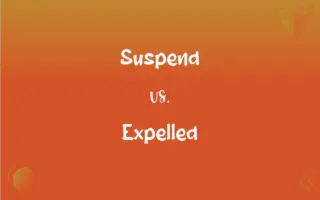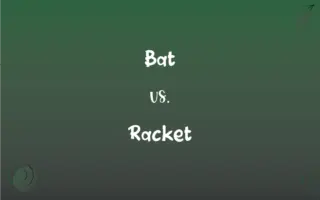Spear vs. Polearm: What's the Difference?
By Janet White || Updated on May 23, 2024
A spear is a long weapon with a pointed tip used for thrusting, while a polearm is a broader category of long-handled weapons including spears, halberds, and pikes, often used for slashing or thrusting.

Key Differences
A spear is a specific type of weapon that consists of a shaft with a pointed tip, primarily designed for thrusting. It is one of the oldest and most versatile weapons, used for hunting and combat throughout history. On the other hand, a polearm is a broader classification of weapons that includes various types of long-handled arms, such as halberds, pikes, and glaives, each designed for specific combat techniques.
In terms of design, spears usually have a simple construction with a straight shaft and a pointed metal or stone head. They are efficient for both throwing and close-quarters combat. Conversely, polearms often feature more complex designs, incorporating blades, hooks, or spikes in addition to the main thrusting point, allowing for a variety of offensive maneuvers.
Spears are often associated with ancient and medieval infantry, who used them effectively in phalanx formations for their reach and versatility. Whereas, polearms were more commonly used by medieval and Renaissance soldiers, who benefited from the extended reach and multiple attack options provided by these weapons.
In modern terminology, the spear is generally seen as a specific type of polearm, emphasizing its pointed tip and straightforward usage. Meanwhile, polearms encompass a wide range of weapons with varied functionalities beyond just thrusting, including chopping and hooking.
Comparison Chart
Definition
Long weapon with pointed tip
Broad category of long-handled weapons
ADVERTISEMENT
Primary Use
Thrusting
Thrusting, slashing, hooking
Design Complexity
Simple
Often complex
Historical Usage
Ancient and medieval infantry
Medieval and Renaissance soldiers
Functionality
Versatile, can be thrown
Multi-functional, extended reach
Spear and Polearm Definitions
Spear
A simple yet effective weapon with a sharp head.
The museum displayed a bronze spear from the Iron Age.
ADVERTISEMENT
Polearm
A category of long-handled weapons, including spears, halberds, and pikes.
The knight carried a polearm to defend the castle.
Spear
Often thrown or used in close combat.
The soldier threw his spear to take down the enemy.
Polearm
Provides extended reach and versatility in battle.
Soldiers used polearms to keep enemies at a distance.
Spear
Symbolizes strength and precision in various cultures.
The spear is depicted in many historical artworks.
Polearm
Often features complex designs with multiple attack points.
The halberd is a type of polearm with an axe-like blade.
Spear
A weapon consisting of a long shaft with a sharply pointed end.
Polearm
Used for thrusting, slashing, and hooking in combat.
Polearms were essential in medieval warfare.
Spear
A shaft with a sharp point and barbs for spearing fish.
Polearm
Popular in medieval and Renaissance military formations.
Polearms were favored by infantry for their multifunctionality.
Spear
A soldier armed with a spear.
Polearm
A close-quarter combat weapon with the main fighting part of the weapon placed on the end of a long shaft, typically of wood.
Spear
A slender stalk, as of asparagus.
Spear
To pierce with a spear or other sharp object.
Spear
To catch with a thrust of the arm
Spear a grounder.
Spear
(Football) To block (an opponent) by ramming with the helmet, in violation of the rules.
Spear
(Sports) To jab (an opponent) with the blade of a hockey stick, in violation of the rules.
Spear
To stab at something with a spear or other sharp object.
Spear
To sprout like a spear.
Spear
A long stick with a sharp tip used as a weapon for throwing or thrusting, or anything used to make a thrusting motion.
Spear
A soldier armed with such a weapon; a spearman.
Spear
A lance with barbed prongs, used by fishermen to retrieve fish.
Spear
(ice hockey) An illegal maneuver using the end of a hockey stick to strike into another hockey player.
Spear
(wrestling) In professional wrestling, a running tackle in which the wrestler's shoulder is driven into the opponent's midsection.
Spear
A shoot, as of grass; a spire.
Spear
The feather of a horse.
Spear
The rod to which the bucket, or plunger, of a pump is attached; a pump rod.
Spear
A long, thin strip from a vegetable.
Asparagus and broccoli spears
Spear
(botany) The sprout of a plant, stalk
Spear
(obsolete) A church spire.
Spear
(transitive) To pierce with a spear.
Spear
To penetrate or strike with, or as if with, any long narrow object; to make a thrusting motion that catches an object on the tip of a long device.
Spear
(gridiron football) To tackle an opponent by ramming into them with one's helmet.
Spear
(intransitive) To shoot into a long stem, as some plants do.
Spear
To ignore as a social snub.
Spear
Male.
A spear counterpart
Spear
Pertaining to male family members.
The spear side of the family
Spear
A long, pointed weapon, used in war and hunting, by thrusting or throwing; a weapon with a long shaft and a sharp head or blade; a lance.
They shall beat their swords into plowshares, and their spears into pruning hooks.
Spear
Fig.: A spearman.
Spear
A sharp-pointed instrument with barbs, used for stabbing fish and other animals.
Spear
A shoot, as of grass; a spire.
Spear
The rod to which the bucket, or plunger, of a pump is attached; a pump rod.
Spear
To pierce with a spear; to kill with a spear; as, to spear a fish.
Spear
To shoot into a long stem, as some plants. See Spire.
Spear
A long pointed rod used as a weapon
Spear
An implement with a shaft and barbed point used for catching fish
Spear
Pierce with a spear;
Spear fish
Spear
Thrust up like a spear;
The branch speared up into the air
Spear
A weapon with a long shaft and pointed tip for thrusting.
The warrior skillfully wielded his spear in battle.
Spear
A tool used for hunting and combat throughout history.
Ancient hunters relied on spears to catch their prey.
FAQs
What are the main uses of a spear?
Spears are used for thrusting, throwing, and close-quarters combat.
Why were polearms popular in medieval times?
Polearms provided extended reach and versatile combat options, making them effective in battle.
Are all spears considered polearms?
Yes, spears are a type of polearm focused on thrusting attacks.
How do polearms differ from spears?
Polearms include a variety of weapons with different functionalities, such as slashing and hooking, while spears are specifically designed for thrusting.
What is a spear?
A spear is a long weapon with a pointed tip used primarily for thrusting.
What is a polearm?
A polearm is a broad category of long-handled weapons that includes spears, halberds, pikes, and other similar arms.
What materials were used to make spears?
Spears were typically made from wood with metal or stone tips.
What is a pike?
A pike is a long polearm with a pointed tip, used extensively by infantry in medieval and Renaissance armies.
Are polearms still used today?
Polearms are no longer used in modern combat but are studied in historical martial arts.
What are some examples of polearms?
Examples include halberds, pikes, glaives, and spears.
How did polearms influence battle tactics?
Polearms allowed soldiers to engage enemies from a distance and perform various attacks, influencing formation strategies.
Were spears used in ancient warfare?
Yes, spears have been used in warfare since ancient times for their simplicity and effectiveness.
What is the difference between a spear and a javelin?
A javelin is a lighter spear designed specifically for throwing.
Can spears be thrown?
Yes, spears can be thrown as well as used in melee combat.
What is a halberd?
A halberd is a type of polearm with an axe blade, a spike, and often a hook.
What is a glaive?
A glaive is a polearm with a single-edged blade at the end, used for slashing.
What role did spears play in hunting?
Spears were essential tools for early hunters, allowing them to take down large prey from a safe distance.
How were polearms used in formations?
Polearms were often used in tight formations to create defensive barriers and offensive fronts.
Were polearms used by cavalry?
While primarily used by infantry, some polearms were adapted for cavalry use.
How long can a polearm be?
Polearms can range from a few feet to over 20 feet in length, depending on the type.
About Author
Written by
Janet WhiteJanet White has been an esteemed writer and blogger for Difference Wiki. Holding a Master's degree in Science and Medical Journalism from the prestigious Boston University, she has consistently demonstrated her expertise and passion for her field. When she's not immersed in her work, Janet relishes her time exercising, delving into a good book, and cherishing moments with friends and family.
































































